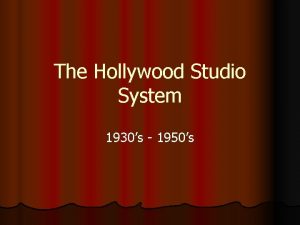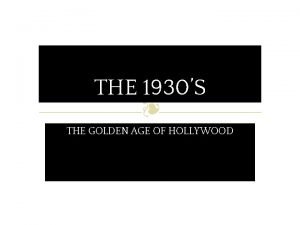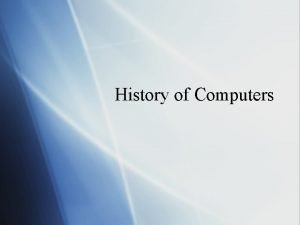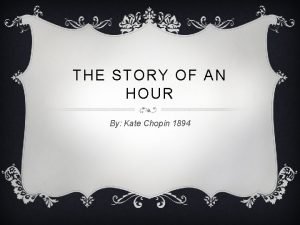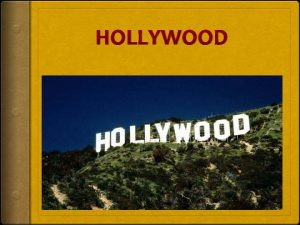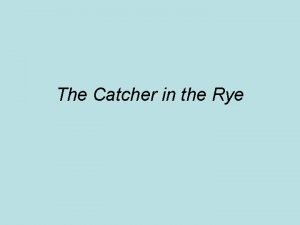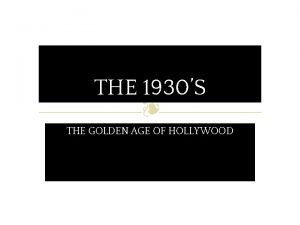The Hollywood Studio System 1930s 1950s Why Hollywood















- Slides: 15

The Hollywood Studio System 1930’s - 1950’s

Why Hollywood is so successful… Six major studios (Universal, Paramount, MGM, Warner Bros. 20 th Century Fox , RKO. ) l Operated production line methods l Stars contracted to studios for lengthy periods, allowed A class feature films (star vehicles) l Studios had enormous control over stars, managing their publicity, how they looked, what roles they got and how they lived. Often able to control any scandals and suppress negative publicity. l

Hollywood Studio System l l Also made regular B pictures (brought in money and acted as a training ground for crew and stars. ) Studios organised around VERTICAL INTEGRATION (controlled production, distribution and exhibition. ) Led to BLOCK BOOKING (If cinemas wanted the main feature had to book other films from the studio - leaving no room for independent films. ) All the interests necessary to create profit under 1 roof.

Hollywood Studio System A tightly controlled industry maximised profits, minimised risk. l Developed a Classical Narrative System and genre production (minimises risk) which audiences liked and came to expect. l

What happened? l l l Paramount Decree (1948) banned vertical integration and block booking. Stars rebelled against long term contracts…they wanted more freedom and choice. De Havilland Decision released stars from these. Directors wanted independence and more artistic freedom. Increased competition from TV in the 1950’s/60’s. Suburbanisation- populations moved out of the cities (near cinemas) into suburbs and watched TV.

Hollywood Then to Now: The rise of the independents MGM, Paramount and Universal began renting their equipment and lots to young independent directors such as Francis Ford Coppola, Martin Scorcese and Steven Spielberg l With the collapse of the studios, the producers and executives no longer had the power to control creative film-making l The influence of a new wave of filmmaking from France (Nouvelle Vague), encouraged Hollywood independents to experiment and develop their own unique styles l

Hollywood Then to Now: The rise of the independents During the 1970 s young graduates of new film schools in California began raising money and negotiating their own deals for films l The success of films by Spielberg such as Jaws and Close Encounters of the Third Kind and Scorsese films Mean Streets and Alice Doesn’t Live Here Anymore proved that popular film audiences would accept variety and change l

Why is Hollywood Different to the Time of the Studio System? l “New Hollywood” = 1975 onwards. l Organised around the blockbuster film (high concept film) l Largely created by directors such as George Lucas and Steven Spielberg and producers such as Jerry Bruckheimer. l The first High Concept film is considered to be Jaws (1975) Spielberg

The Star System: New Hollywood Actors and directors are no longer contracted to studios. An actor has an agent who protects their interests, controls public relations and gets them work. l Much more freedom and can make A class feature roles alongside independent films e. g. Brad Pitt appeared in The Mexican and Troy. l Can command huge fees = Will Ferrell $20 million (Blades of Glory. ) l

So Why is Hollywood Still So Successful? l Studios are powerful and efficient with nearly a century of profitable experience. In many cases vertical integration is back e. g. Universal make films and distribute them and own multiplexes in Europe and beyond. l Well established studios mean massive budgets.

New Hollywood: The High Concept FIlm Studios make fewer films, production is organised around a small number of very expensive ($100 million +) blockbusters, which if successful can keep the studio afloat. US frequently top $100 mill l (Transformers $150 million, King Kong $209 million, Spiderman 2 $275 mill Spiderman 3 - $295) Whereas average Brit spend is 5 million pounds. l l Moved towards HIGH CONCEPT filmmaking (event movies) that if a summer success can keep the studio in profit. l A HIGH CONCEPT film is organised around a simple narrative, moving from one spectacular set piece to another. The genre is often action based allowing for the visceral excitement of high speed chases, SFX etc…

The High Concept Film l The High Concept film rarely appears as a single entity- studios member of conglomerate involved in music production, computer games, TV studios and other merchandising opportunities. SYNERGY: Therefore a film makes money in several ways. l DVD, Video, Pay Per View TV have given films longer shelf life than during the studio system. Films are resold in different formats. l

The Hollywood Product l Hollywood relies on pre existing products (remakes, sequels, franchises, books, comics, TV programmes) E. g. Star Wars, Harry Potter, Beowulf, The Golden Compass, Spiderman, Fantastic Four, Sin City, 30 Days of Night etc…

Distribution Practices l US studios pour millions into distribution, particularly marketing (Pearl Harbor premiere- $5 million. ) l HW films achieve BLANKET COVERAGE. Blockbusters open in the UK on 450 screens- nearly all multiplexes (whereas Brit films on as few as 10. ) Hollywood still operates on a STAR SYSTEM so A list stars (Julia Roberts, Tom Cruise etc) can open a movie and almost guarantee profit. l The star system is fuelled by contemporary celebrity culture supported by magazines, TV, tabloids and award ceremonies. l

Why is Hollywood still successful? Big studios cornered the independent market by setting up independent production arms e. g. Miramax originally set up by Disney. l Hollywood has started looking toward audiences beyond the US and Europe by using stars or narratives that will appeal to other markets e. g. Jackie Chan, Jet Li, John Woo, J-Lo (Latino audiences. ) The Last Samurai and Kill Bill play well in Eastern markets. l Hollywood started earlier than UK in upgrading cinemas to multiplexes- complete leisure experience. l The growing audience in the UK is mainly for Hollywood films. Hollywood accounts for 70 -80% of UK box office takings. l
 The hollywood studio system in the 1930s and 1940s
The hollywood studio system in the 1930s and 1940s Golden age of hollywood 1930s
Golden age of hollywood 1930s Hey bye bye
Hey bye bye Xna visual studio 2017
Xna visual studio 2017 Xna game studio visual studio 2017
Xna game studio visual studio 2017 The golden age of comics
The golden age of comics 1930s era entertainment
1930s era entertainment Benito mussolini aggressive actions
Benito mussolini aggressive actions What happens when weathering and erosion work together?
What happens when weathering and erosion work together? Computers 1930s
Computers 1930s Dont ask why why why
Dont ask why why why 1950s home economics textbook
1950s home economics textbook 1950s computers
1950s computers 1950s fashin
1950s fashin 1950s future cars
1950s future cars The affluent society 1950s
The affluent society 1950s
